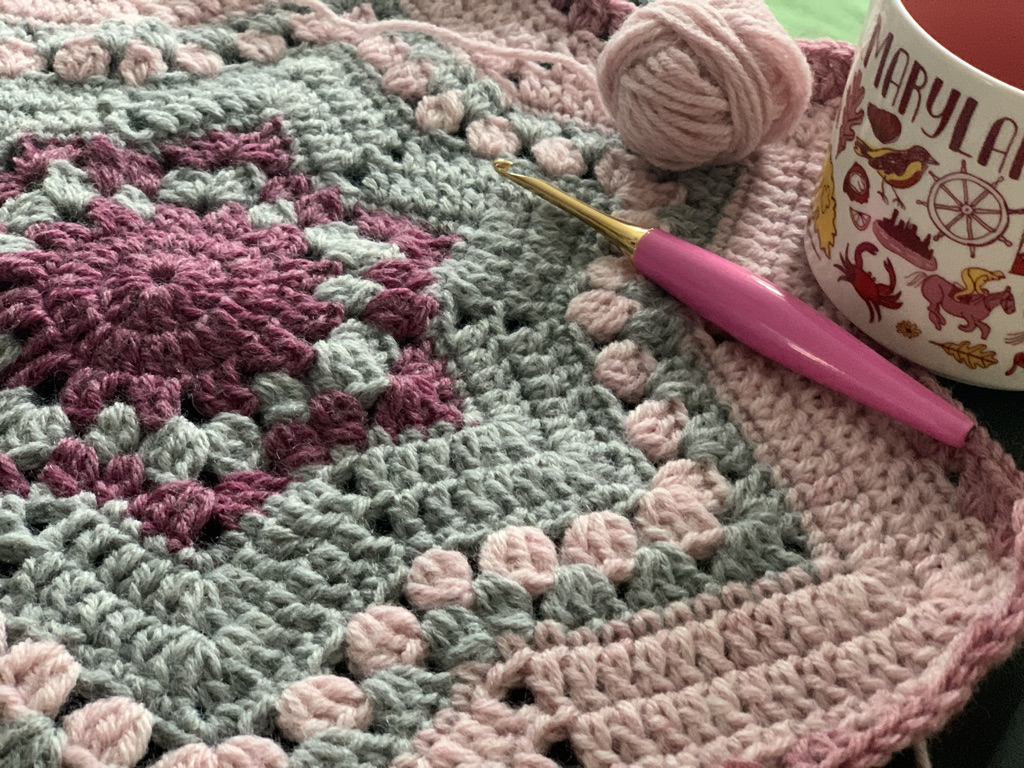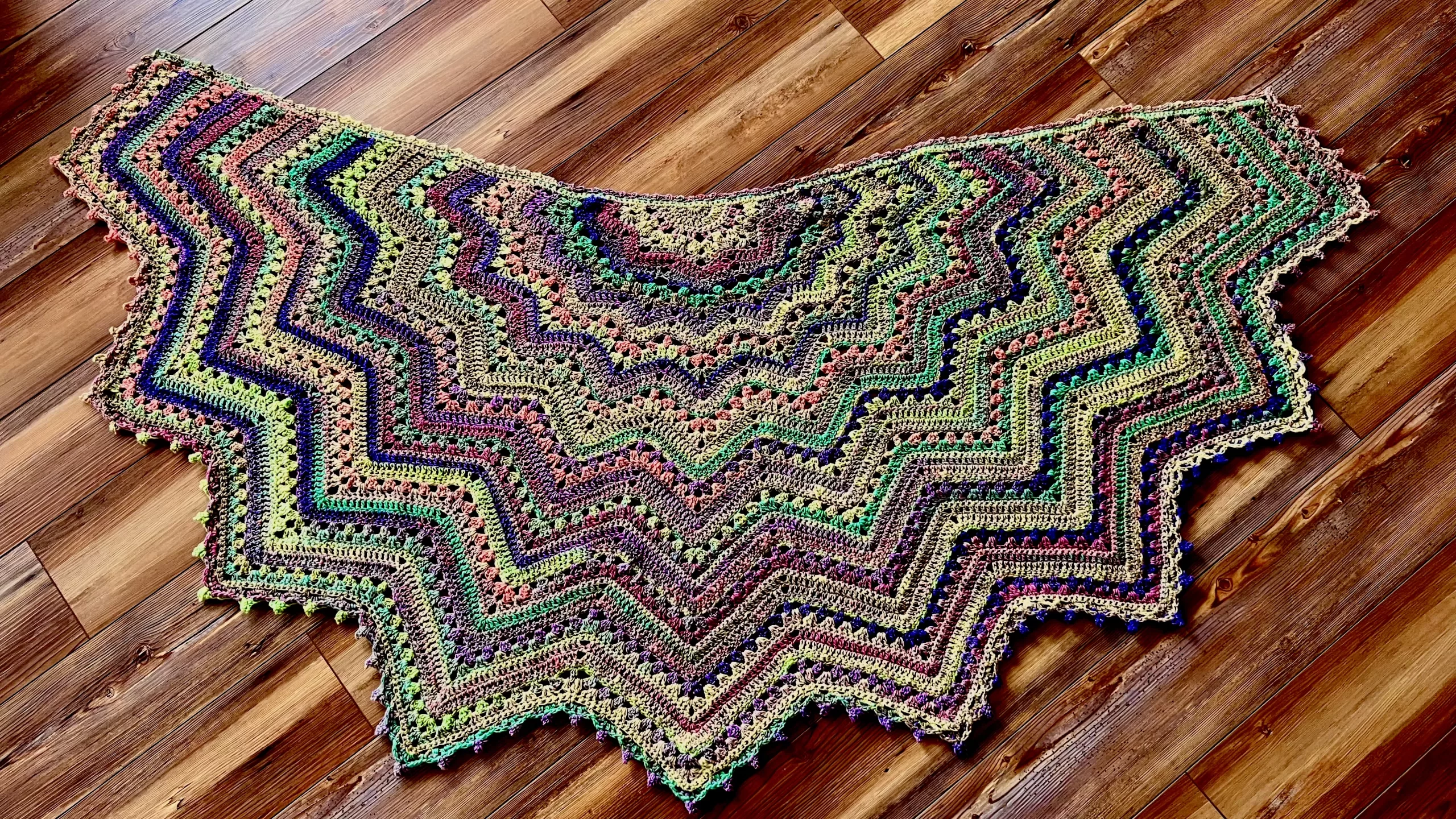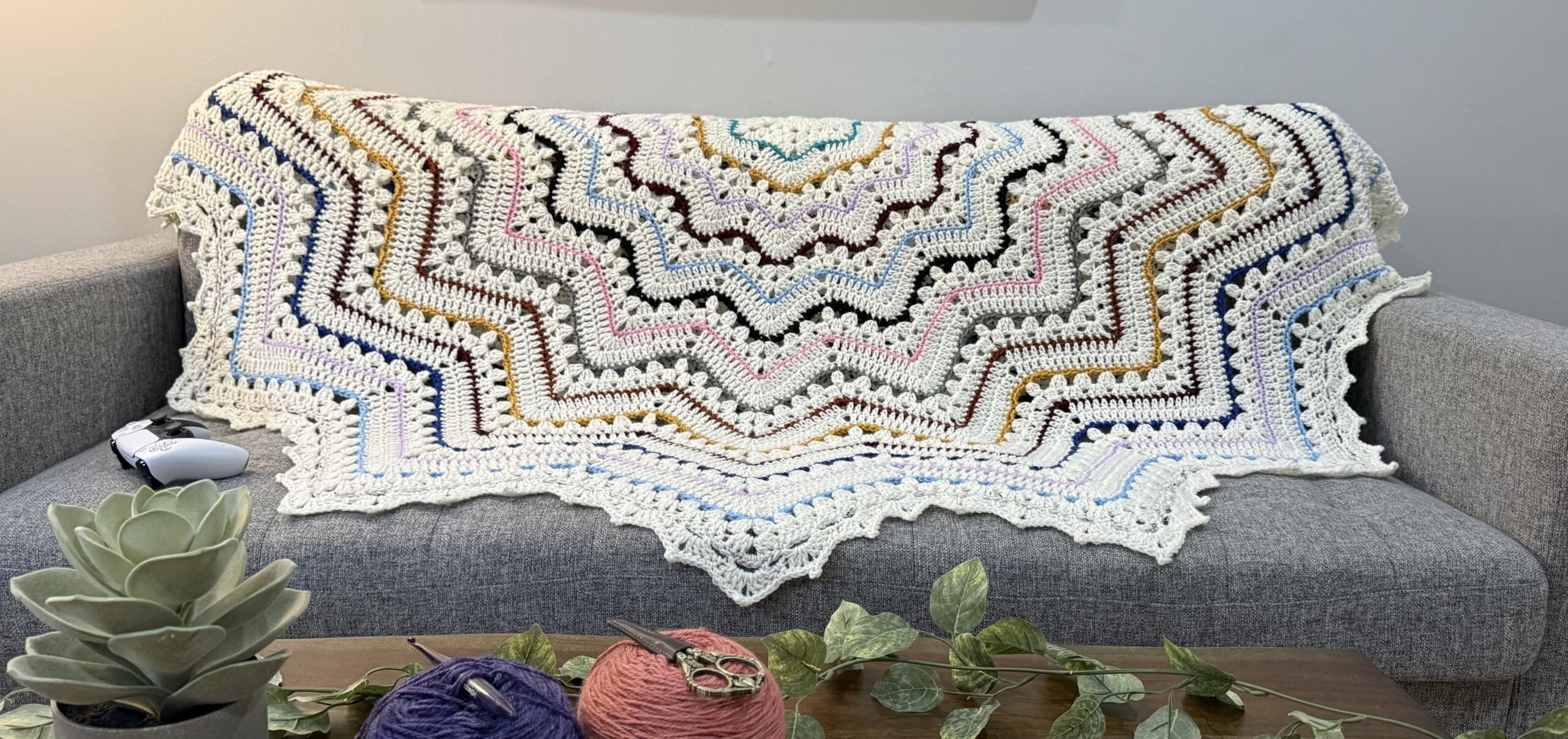6-Day Staro Shawl featuring Noro Yarn


A variation of the classic crochet pattern the
6-Day Kid Blanket by Betty McKnit
Purchase a Yukata Kit for this project at Knitting Fever (affiliate link).
Introduction
This pattern is an adaptation of the 6-Day Star Blanket and 6-Day Star Shawl by Betty McKnit adapted especially for Noro Yarn. It creates a stunning, slightly more than half-circular star-shaped shawl with five large points and a unique border.
There is also a shawl adaptation of the 6-Day Superstar Blanket and Shawl for Noro Yarns called the 6-Day Superstaro Shawl.
This page contains affiliate links. If you click these links and buy something on the page they take you to, I may, at no additional cost to you, earn a commission. I only affiliate with products and companies I feel good about. Thank you for your support!



Details:
US Terminology
Skill Level: Easy
Finished Size: 70”wide, 30” long.
Materials
Yarn: 2 balls of Noro Yukata, shown in #4 Saitama
or 1500 yards of #2 Weight Yarn
Purchase a Yukata Kit for this project at Knitting Fever (affiliate link).
Hook: Size H (5 mm)
Stitch markers
Yarn needle for weaving in ends.
Optional: Shawl Clip, pin, button or other closure.
Abbreviations
bet: between
ch: chain
dc: double crochet
dc3tog: double crochet 3 together cluster (see below)
fpdc: front post double crochet
fphdc: front post half double crochet
hdc: half double crochet
picot: (sc, ch 2, sc in side of sc just made)
sc: single crochet
sl st: slip stitch
sp(s): space(s)
st(s): stitch(es)
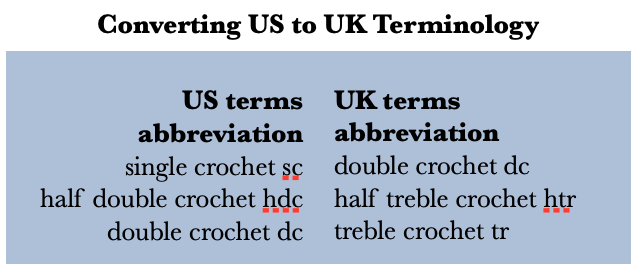
Special Stitches:
dc3tog (cluster) – this stitch is a cluster, not a decrease. It is worked as follows: yo, pull up a loop, pull through two loops, *yo, pull up a loop IN THE SAME STITCH/SPACE, pull through two loops, repeat from *, yo and pull through all loops on the hook. dc3tog complete.
About the row numbers:
In order to provide consistency across all of the 6DKB pattern variations, I’ve numbered the rows to correspond to the original 6-Day Kid Blanket pattern. The cluster rows are always Row or Rows 2 and 3, the dc rows are always Rows 5 and 6, and the sc rows are always Rows 4 and 7. This makes it easy to remember the pattern sequence once you’re familiar with the 6DKB.
Color Pooling
Noro is a self-striping yarn variegated yarn with amazing color combinations. The yarn is meant to mimic how colors appear in nature, therefore there is an artistic inconsistency in the way the colors appear in the yarn. Sometimes colors do not flow in the same order each time, nor are the lengths of color consistent. There is no way to predict exactly how the colors are going to flow, so be prepared to be amazed and delighted.
I found at the sides of the work that there was sometimes a pooling effect due to reversing the direction of the stitches. I alternated the cakes of yarn changing cakes every two rows in order to balance any color pooling. A few times I removed a prominent color if it was showing up on the same side too much and added it to the other side of the work. This is completely optional. This project is yours to work up to your satisfaction.

Changing Yarns
I treated alternating the yarns like any other color change, pulling the new yarn through the last two loops of the last stitch of the row. There is no need to fasten off; carefully carry the other yarn up the side of the work taking care to keep the tension like Goldilocks – not too tight, not too loose, but just right.
At the beginning of the rows, work into st below the turning chain unless directed otherwise.
Begin Pattern
Ch 4, join with sl st to form a ring (magic loop not recommended).
Set-up Row 1: ch 2 (does not count), 9 dc into ring. (9 dc total)
Turn
Set-up Row 2: ch 2 (does not count), 2 dc in same st. 2 dc in each st cross. (18 dc total)
Turn
(to avoid pooling, change to the second ball here)
Set-up Row 3: ch 1, sc in same st and each st across. (18 sc)
Turn
Set-up Row 4: ch 2, dc, *ch 3, 2 dc, ch 1, 2 dc, repeat from * to last dc, ch 3, dc in last dc. (5 ch 3 sps and 4 ch 1 sp. Note: 2 dc are NOT made in the same st.)
Turn
(To avoid pooling, change back to the first ball. Continue to change balls after every two rows, carrying the yarn up the side edge, taking care not to pull the floats too tight.)
Set-up Row 5: ch 3, [3 dc, ch 3, 3 dc] in ch 3 sp. *dc3tog in ch 1 sp, [3 dc, ch 3, 3 dc] in ch 3 sp, repeat from * across, dc in top of turning chain.
Turn

Set-up Row 6: ch 3, *[3 dc, ch 3, 3 dc] in ch 3 sp, dc3tog in next 2 sps, repeat from * to last peak, [3 dc, ch 3, 3 dc] in last ch 3 sp, dc in turning ch.
Turn
Set-Up Row 7: ch 1, sc in same st, sc in each st across, working 3 sc in ch 3 sps, finish by sc in turning ch. (55 sc).
Turn
Set Up Row 8: ch 3, counting the st under your ch sk 2, 3 dc, *[5 dc in center sc from row below], 4 dc, sk 2, 4 dc, repeat from * to last peak, [5 dc in center sc from row below], 3 dc, sk 1, dc in last sc.
Turn
Set Up Row 9: ch 3, counting the st under your ch sk 2, 4 dc, *[5 dc in center dc from row below], 5 dc, sk 2, 5 dc, repeat from * to last peak, [5 dc in center sc from row below], 4 dc, sk 1, dc in turning ch.
Turn
Set Up Row 10: ch 1, sc in same st, 6 sc, *4 sc in center dc, 14 sc, repeat from * to last peak, 4 sc in center dc, 6 sc, sc in turning ch.Turn
Proceed to Row 2
Don’t let the row numbers throw you off or overthink a change in the sequence. You’ll proceed from Setup Row 10 to Row 2.
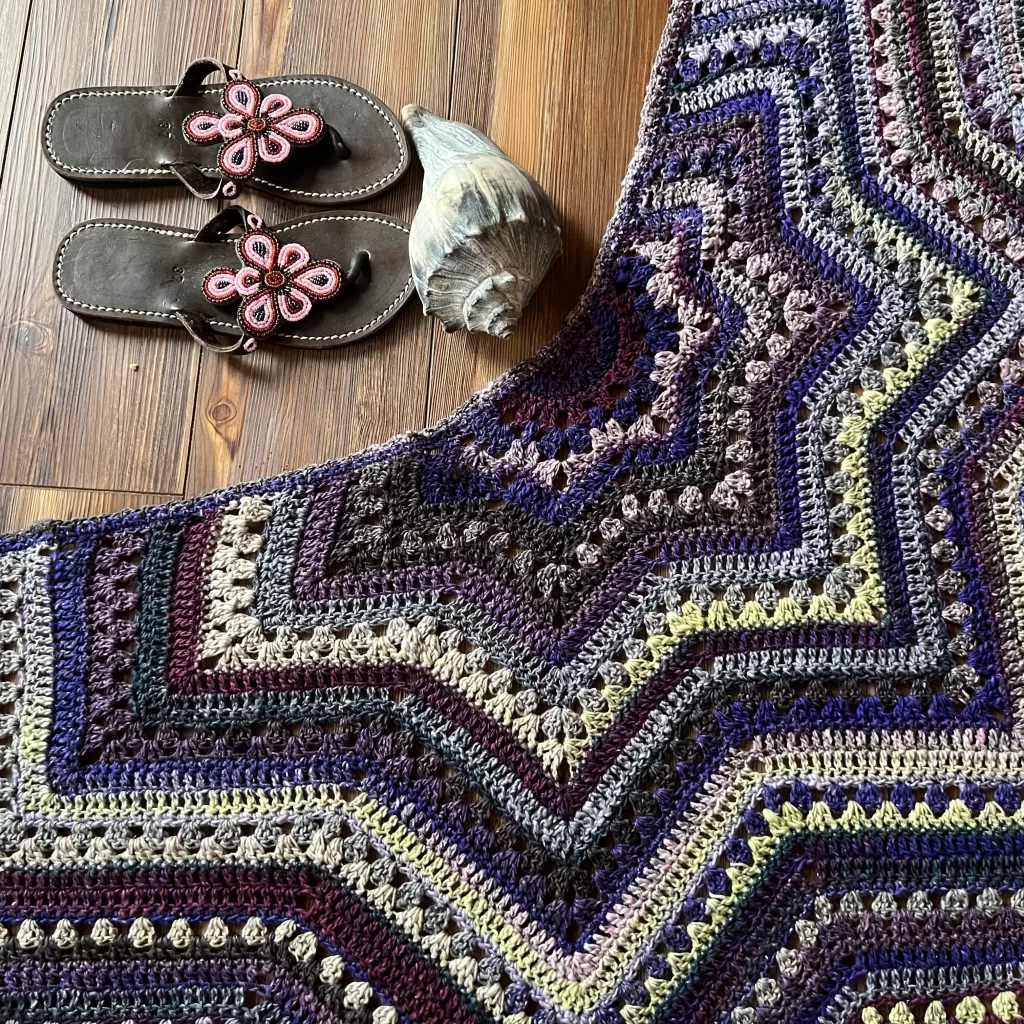
Row 2: ch 3, counting the st under your chain, sk 3, 3 dc in next sc, *[sk 2, 3 dc in next st], repeat from * to top of the mountain, [3 dc, ch 3, 3 dc] in third of 4 sc, **[sk 2, 3 dc in next st], repeat from ** making last 3 dc in the third sc from the center valley st, sk 2, dc3tog in the center valley st, repeat from * to last 2 sts, sk 1, dc in last st.
Turn
Row 3: ch 3, sk sp between turning ch and 3 dc, *3 dc in next sp, repeat from * to top of the mountain, [3 dc, ch 3, 3 dc] in ch 3 sp, **3 dc in next sp, repeat from ** to the valley, dc3tog in sps before and after the dc3tog in the row below, repeat from * to end, dc in last turning ch sp.
Turn
Row 4: ch 1, sc in same sp, 9 (15, 21, 27, 33, 39, 45) sc, * 3 sc in ch 3 sp, 20 (32, 44, 56, etc.) sc, repeat from * to last ch 3 sp, 3 sc in ch 3 sp, 9 (15, 21, 27, 33, 39, 45) sc, sc in turning ch.
Turn
On subsequent sc rounds, the number of scs on either side of the mountain will increase by 6. The numbers in parentheses show the number of scs on each subsequent repeat of the pattern.
Row 5: ch 3, counting the st beneath your ch sk 2, 9 (15, 21, 27, 33, 39, 45) dc, *[5 dc in center sc from row below], 10 (16, 22, 28, 34, 40, 46) dc, sk 2, 10 (16, 22, 28, 34, 40, 46) dc, repeat from *, 9 (15, 21, 27, 33, 39, 45) dc, sk 1, dc in last st.
Turn
Row 6: Ch 3, counting the st beneath your ch sk 2, 10 (16, 22, 28, 34, 40, 46) dc, *[5 dc in center dc from row below], 11 (17, 23, 29, 35, 41, 47) dc, sk 2, 11, (17, 23, 29, 35, 41, 47) dc, repeat from *, 10 (16, 22, 28, 34, 40, 46) dc, sk 1, dc in last st.
Turn
Row 7: ch 1, sc in same st and each st across, making 4 sc in each center of 5 dc from the row below. (You should have 13 (19, 25, 31, 37, 43, 49) sc on each side of the peak and 4 sc in each center dc st).
Repeat Rows 2-7 six times, ending on row 7. Do not fasten off or turn. Proceed to Top Edge Row 1.

Top Edge
Top Edge Row 1: On your final row, make 3 sc in the last st of the row and continue down the sides the rows/across the top edge of the shawl. Treating the turning chains and the sc and dc stitches like foundation chains, work sc across the top edge working under 2 threads of each stitch and leaving one thread below. This creates a beautiful even edge to the work. The number of sc you will put in each stitch will vary depending on your tension. Lay your work down often to check that your edge is laying flat and adjust the number of stitches accordingly.
Turn.
Optional Buttonholes for Closure: Place two stitch markers on the top edge of the shawl, each halfway between the center and the edge of the work, or wherever you would like to put your closure. If you are planning to use a button to close the shawl, you can just mark one side.
Top Edge Row 2: ch 2, hdc in each st across. For buttonhole, work (ch 2, sk 1) at marked stitches.
Turn
Top Edge Row 3: ch 1, (sc, ch 1, sc) in same sp, *sk 1, (sc, ch 1, sc) in next st. Repeat from * across, end with sc in last st. At buttonhole, work 3 sc in ch 1 sp.
Do not turn or fasten off. Proceed to Border Row 1.

An international community of yarnful makers and friends.
- New pattern pre-releases
- Exclusive patterns never released to the public
- Have access to Betty’s ad-free .pdf library of patterns (3-4 patterns/month)
- Access to Betty’s Design Workshop
- Uplevel your knitting and crochet skills
- Enjoy regular crochet alongs, knit alongs, and classes
- Make like-minded friendships during our weekly social and educational events
- Bonus content every month
Border
Border Row 1: Continuing from Top Edge Row 3, ch 3, sc in the first sc of the last shawl row. *sk 2, ch 3, sc in next st, repeat from * across. Fudge your skips so that the ch sps fall across the peaks and valleys, and so that you have an even number of ch sps between each peak, and an odd number on each end. (I had 17 sps on each end, one over each peak, one over each valley, and 16 in between peaks).
Turn
Border Row 2: ch 1, sc in same st, ch 3, sc in ch 3 sp, *(3 dc, ch 2, 3 dc) in ch 3 sp, sc in next ch 3 sp, repeat from * to peak, (4 dc, ch 3, 4 dc) in ch 3 sp in peak, repeat from * to valley, sc in valley sp. Continue in this pattern across, end with sc in last ch 3 sp, ch 3, sc in last sc.
Turn
Border Row 3: ch 3, sc in ch 3 sp. *3 fphdc, (sc, picot, sc) in ch sp, 3 fphdc, sk 1, repeat from * to peak, 4 fphdc, (sc, picot, sc) in ch sp, 4 fphdc, in peak, sk 1, repeat from * across. End with sc in last ch 3 sp, ch 3, sc in last sc.
Fasten off. Weave in all ends.
Optional: Add closure to top edge.

Pattern Tested by KD Wright, Peta Gehrmann, Laura Cromwell, Lecisha Eacholes and Dianne Kagay.
Special thanks to KD Wright, Peta Gehrmann, and to the citizens of the Betty McKnitiverse. for their work on the development of this pattern.
Join us in the 6-Day Kid Blanket Facebook Group for help with this pattern. Video tutorials for the 6-Day Star Blankets, which you may find helpful in working this pattern, are available on my YouTube Channel.
This pattern is 100% original and the intellectual property of Betty McKnit/Beth Elliott. This pattern, The 6-Day Kid Blanket, “6DKB,” 6-Day Star Blanket, and derivative works are protected by copyright. Publishing translations, corrections, variations, or tutorials of this pattern, online or elsewhere without written permission from the owner is a violation of copyright.
Items created with this pattern may be used for commercial sale with credit to Betty McKnit in your listing.
Be sure to tag @bettymcknit in your social media posts so I can enjoy your beautiful creations.
Border is inspired by Around the Corner Crochet Borders and Every Which Way Crochet Borders by Edie Eckman.
Beth McKee Elliott
aka Betty McKnit
Beth McKee Elliott, also known as Betty McKnit, is a crochet and knitting designer, instructor, community leader, and Master Somatic Movement Therapist and Educator. Her signature style, 6-Day Crochet, is showcased in the viral crochet patterns the 6-Day Kid Blanket and 6-Day Star Blanket.
She specializes in Somatic Crochet and Knitting, a mindfulness practice that combines crochet/knitting with body awareness techniques to prevent injury and promote well-being and creativity in crafting.
In addition to being a crochet designer, Beth is a choreographer. She is the creator and director of Small Plates Choreography Festival, Haven Movement Company, and the Dance Maker Podcast.
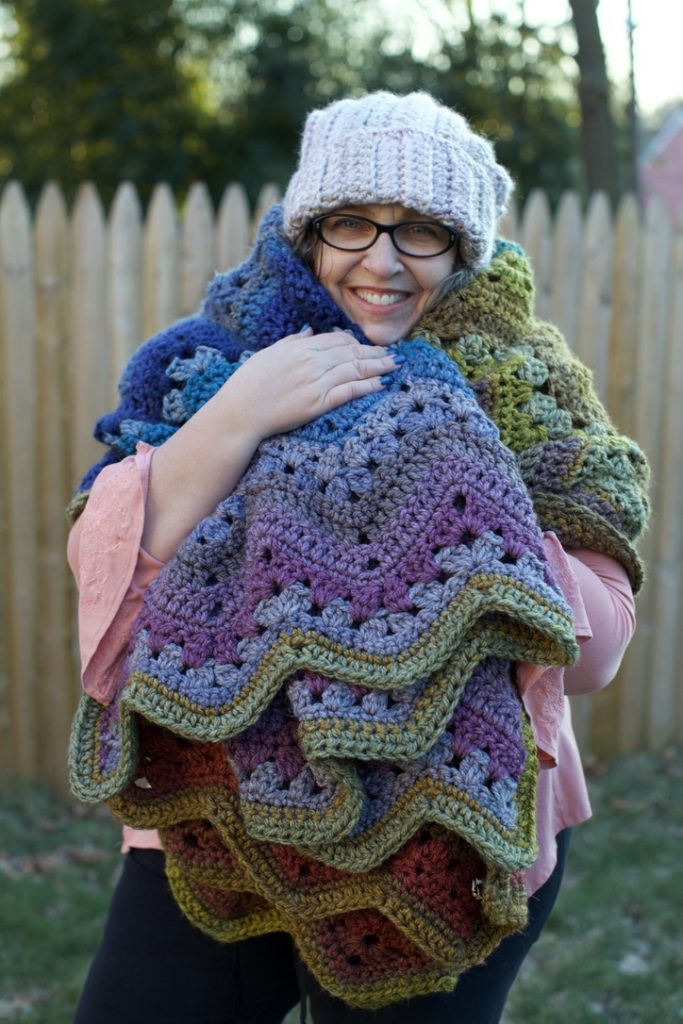
© Beth McKee Elliott aka Betty McKnit ®
www.bettymcknit.com



